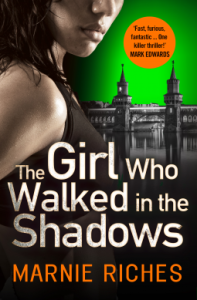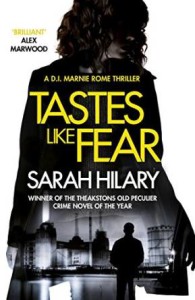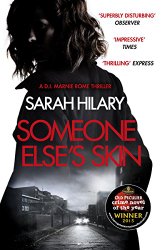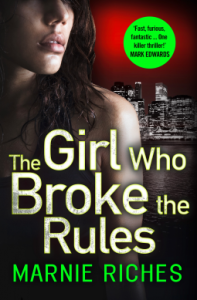In Conversation: Marnie Riches & Sarah Hilary
This is the third Conversation guest post I have been able to share. I wish I could say that I had planned this wonderful symmetry, however, it is by sheer chance that my latest guests have both just released the third novel in their respective series.
Frequent visitors to Grab This Book will know that I am huge fan of The Girl Who series by Marnie Riches and also of Sarah Hilary’s Marnie Rome thrillers. I make no secret of the fact I enjoy the darker crime novels and Sarah and Marnie’s books have consistently scored my highest review scores as they write the books I love to read.
In my ongoing attempts to give my guests the best chance to discuss their books (away from an inflexible pre-prepared Q&A format) I was delighted when Sarah and Marnie agreed to join me to chat about their ‘kick ass’ heroines…and what-ever else that may crop up!
 G: Marnie, we are starting our chat just a few days after the launch of The Girl Who Walked in the Shadows – the 3rd outing for George McKenzie. I have seen quite a few reviews suggesting that this is her darkest adventure thus far. The first two books were no gentle stroll in the park for George, so did you feel that you raised the stakes this time around?
G: Marnie, we are starting our chat just a few days after the launch of The Girl Who Walked in the Shadows – the 3rd outing for George McKenzie. I have seen quite a few reviews suggesting that this is her darkest adventure thus far. The first two books were no gentle stroll in the park for George, so did you feel that you raised the stakes this time around?
MR: Thanks for this. My publisher had suggested I continue a theme of sexuality and traffic into this third book. I guess you don’t notice common themes emerging in your work until you’ve written more than one novel. So, it seemed appropriate to explore the subject matter of child-trafficking and paedophile rings in The Girl Who Walked in the Shadows. I felt I could do the topic justice. I still wanted the book to be a serial killer thriller, as I like to read that sort of thing myself, but I did have memories of the Madeleine McCann disappearance churning away in the back of my mind for years. It struck a chord with me as a parent – hence, a thriller with two mysteries at its heart emerged: Jack Frost with his lethal icicles, and the disappearance of the Deenen toddlers. So, yes. In a bid to avoid writing a samey, formulaic third installment in my series, I upped the ante and went darker and more complex. It seems to be going down well with readers.
What about you, Sarah? What demons did you face in coming up with a story-line for your third?
SH: Marnie, it’s interesting what you say about not noticing common themes until you’ve written a book or two. That really came home to me when I was writing book three. I knew I was affected by my family history – my mother was a child internee of the Japanese during WWII – but I hadn’t realised how strongly I felt about the twin themes of fear and captivity until I was writing Tastes Like Fear. It took a reader to point out that I often write about children who are trapped or taken, or both. Marnie’s backstory (love that you share a first name with my heroine, btw!) involves quite a lot of demon-facing, and at one level she’s trapped by her inability to let go of her past. So Tastes Like Fear works in terms of the standalone story, which is about lost teenagers thinking they’ve found a safe place, and the longer story that underpins the series.
 Marnie, how far ahead do you plan in terms of George’s story? Do you know where she’s headed, or do you like to be surprised, book by book?
Marnie, how far ahead do you plan in terms of George’s story? Do you know where she’s headed, or do you like to be surprised, book by book?
MR: Wow, Sarah. You have such an interesting family history. That must have been very difficult for your mother to get over, as childhood events have such an impact on adult life. In a similar vein to your Mum and Marnie Rome and George McKenzie, I endured traumatic events when I was younger (nothing like your mother’s experience, of course) where I was subject to being terrorized on a very rough council estate over a period of many years. My mother and I acted as magnets for the feral kids who roamed the estate in gangs. The petrol-bombing scene in The Girl Who Wouldn’t Die actually happened to me, so that phenomenon of the fight or flight impulse never being far beneath the surface had to be a major characteristic in George, else she wouldn’t have been mine. Over the series, George works hard to subvert these destructive impulses that are a hangover from her earlier years.
I know George will follow an arc but I don’t know until I start to write exactly what shape that will take. She is not me, but her development is influenced by my own personal development to an extent. So, as she ages, she may have more control over her extremes of emotional and may be more stoic about the treacherous behaviour of family members, for example. I have to know what the standalone story will be for the next book – I have had to submit proposed outlines for The Girl Who Broke the Rules and The Girl Who Walked in the Shadows, to get my publisher’s prior approval – but George’s long game is mine to play…
You and I both have a toughie of a female protagonist, paired with somewhat beta males in Marnie & Noah and George & Van den Bergen. What made you choose that dynamic?
SH: Marnie, I may have some dark family history but how dreadful for you to have lived through such trauma as a child. By contrast I was fortunate enough to have an extremely secure and happy childhood. Which is perhaps why I gravitated towards horror stories and crime fiction as a way of expanding my emotional arsenal, vicariously as it were. I’ve not experienced even a little of what my Marnie has, but perhaps I’m channelling some creative demons into her? Hard to say, but I am wedded to her darkness. While I would like her to find peace from time to time, I have no end game in sight that would involve a ‘happily ever after’ scenario. Some people, I think, are born into the world to carry weight on their shoulders (I do know a little about this, personally) and Marnie is one of that breed. The world needs heroes like Marnie and George.
 Do you love writing Van den Bergen as much as I love writing Noah? I’m not sure what drew me to the dynamic, but I find it fascinating (and useful, in terms of plot and character) to see Marnie through Noah’s eyes. Their relationship has changed a lot since Someone Else’s Skin. Marnie trusts Noah now, and she even confides in him. Has the dynamic between Van den Bergen and George changed as you’ve been writing the three (soon to be four) books?
Do you love writing Van den Bergen as much as I love writing Noah? I’m not sure what drew me to the dynamic, but I find it fascinating (and useful, in terms of plot and character) to see Marnie through Noah’s eyes. Their relationship has changed a lot since Someone Else’s Skin. Marnie trusts Noah now, and she even confides in him. Has the dynamic between Van den Bergen and George changed as you’ve been writing the three (soon to be four) books?
MR: Van den Bergen is one of those people who carries a burden. He suffers with anxiety disorder and the occasional slide into full-on depression. I enjoy writing him because he’s such a loveable, cantankerous bastard with such unimpeachable morals. I like exploring his masculinity – it’s fascinating to be able to inhabit a man’s body and a man’s take on the world through my writing.
George, on the other hand, is an optimist at heart, with an incredible capacity to love, tempered by her worldly-wise cynicism. She’s a heroine because she’s had a hard start and has had to become extremely tough and resilient to survive and flourish. She has inner steel and discipline, where her family life is chaotic to say the least.
George and Van den Bergen were always attracted to one another – they respected each others’ grit, determination and attention to detail from the word go, as well as there being bonkers sexual chemistry. Their relationship has become more antagonistic over time, simply because of Van den Bergen’s anxiety about his age – there’s a twenty-year age gap. He drops the shutters on passionate George, who trusts him with her heart so readily. She wants to beat him to a pulp for it.
My main characters both contain a healthy dose of me but are fundamentally different. George is Black and young. Noah is a gay man. Neither Black women nor gay men are particularly well represented in crime fiction. How much of you is in your characters and what made you want to write Noah as gay?
SH: I will confess to a little wish fulfilment when it comes to Marnie, but there is nothing of me in my characters. It’s pure imagination. I wish I had Marnie’s courage and her dry wit, and that I’d been a rebellious teenager, even just for a short while. But I was a very good girl; maybe I’m acting out a fantasy of a misspent youth …
When it comes to Noah, I’m not sure why I wanted to write him as gay, other than as you say, because of under-representation in the genre. I’ve written quite a lot of gay men, so I knew I could do it and I knew that I’d enjoy writing him. A half-Jamaican openly and happily gay man, who happens to also be a detective sergeant with the Met Police. The only conscious decision I made was that his race and sexuality wouldn’t define him. I didn’t want to write about a conflicted character who felt the lash of homophobia and racism every day, or struggled to find personal and professional happiness. Noah is extremely content in his own skin. He goes home to a happy, secure life. He’s armour-plated against the casual bullying in the workplace; nothing fazes him, or not for long. I love Noah.
Let’s talk about our supporting cast. Are there any characters in the standalone plots within each book which you’d like to see return in future books? Or any you’d consider for a spin-off series of their own?
 MR: Similarly, it was a conscious choice for me to make George mixed race, as commercial crime fiction is a very white realm and I wanted to redress that balance somewhat in having a strong Black female lead – most importantly, a lead who isn’t a victim and whose strength does not lie in typically masculine characteristics.
MR: Similarly, it was a conscious choice for me to make George mixed race, as commercial crime fiction is a very white realm and I wanted to redress that balance somewhat in having a strong Black female lead – most importantly, a lead who isn’t a victim and whose strength does not lie in typically masculine characteristics.
As far as reprising the roles of secondary characters goes, both family members and key figures in the criminal underworld crop up repeatedly in the standalone stories. They are essential to the overarching themes that span the series – George’s relationship to her parents and an examination of the rotten heart of trafficking. But George and Van den Bergen are very much the stars. At this stage, I can’t envisage spin-offs. I would, however, like to see more of Silas Holm. In The Girl Who Broke the Rules, he is one of George’s study subjects – an amputee convicted serial murderer and award-winning anaesthetist. He’s intelligent, charming and warped as hell. I think we might see him putting in another appearance. I’ll think on it…
What about you? Do you think you’ll tire of writing about Marnie and Noah? Are there subsidiary characters who would make interesting main protagonists themselves? I’ve worked hard to keep all three of my books familiar and yet, distinctly different from one another – especially The Girl Who Walked in the Shadows. What about you? Are you concerned about your writing becoming formulaic over time, as is often the problem with longer running series?

SH: Silas Holm is a great name as well. I can see a spin-off series for Silas.
One reader did suggest that Noah’s reprobate kid brother, Sol, should have his own series, but I dunno. Someone else would have to write it, I think. I’m too busy – and happy – writing Marnie and Noah. I’m quite intrigued by the idea of some early (pre-series) stories, maybe about Marnie’s wild youth, or Noah’s adventures growing up. Although I do think most of my interest lies in unwrapping them further as the series progresses. Marnie, especially, is still keeping secrets from me (Marnie is made of secrets). In Tastes Like Fear, Noah surprised me with a big secret from his youth, so maybe he has a few tricks up his sleeve, also. As long as they can keep evolving as characters then I don’t need to worry about becoming formulaic.
What long-running crime series do you most enjoy? I’ve just discovered Mick Herron’s stupendous spy thriller series that started with Slow Horses. And I’m a sucker for Jonathan Kellerman’s Alex Delaware series.
MR: I’ve enjoyed Jo Nesbo’s Harry Hole series best, I guess. He’s been going for many, many books and the stories still work well as standalones. By Phantom, however, I did think it was time to wrap things up for Harry and I’m surprised that Police was released. Despite that, it was an enjoyable read. I read a lot of kids’ fiction too, as I used to write that. I enjoyed many of Eoin Colfer’s Artemis Fowl books and also Christopher Paolini’s Inheritance Cycle. Stieg Larsson’s Millennium Trilogy was brill but I haven’t yet read Lagercrantz’s fourth offering, so my jury is out on that.
 I think the joy of a great series is knowing when to stop. Personally, I think George has a good few more stories in her, but I will have to make swingeing changes to the cast list to keep it fresh overall. As long as readers want her, I will write her. Heroines like her come once in a writer’s lifetime – she’s certainly too good to shelve after a mere handful of books. She still has plenty to say!
I think the joy of a great series is knowing when to stop. Personally, I think George has a good few more stories in her, but I will have to make swingeing changes to the cast list to keep it fresh overall. As long as readers want her, I will write her. Heroines like her come once in a writer’s lifetime – she’s certainly too good to shelve after a mere handful of books. She still has plenty to say!
SH: Long live George and Marnie! Great chat, thanks for hosting, Gordon, and a big thank you to our readers who keep us motivated to write more stories with our series characters.
I would like to extend a massive ‘Thank You’ to Sarah and Marnie for giving me the opportunity to eavesdrop on their conversation. As you can see my involvement was minimal but I don’t have the words to describe how much I enjoyed seeing their chat come together.
You can order Sarah’s Marnie Rome novels through this link: http://www.amazon.co.uk/Sarah-Hilary/e/B00QETWXA6/ref=sr_tc_2_0?qid=1461102062&sr=1-2-ent
Marnie’s George McKenzie novels can be ordered through this link: http://www.amazon.co.uk/Marnie-Riches/e/B00WBJZ364/ref=sr_tc_2_0?qid=1461102237&sr=1-2-ent